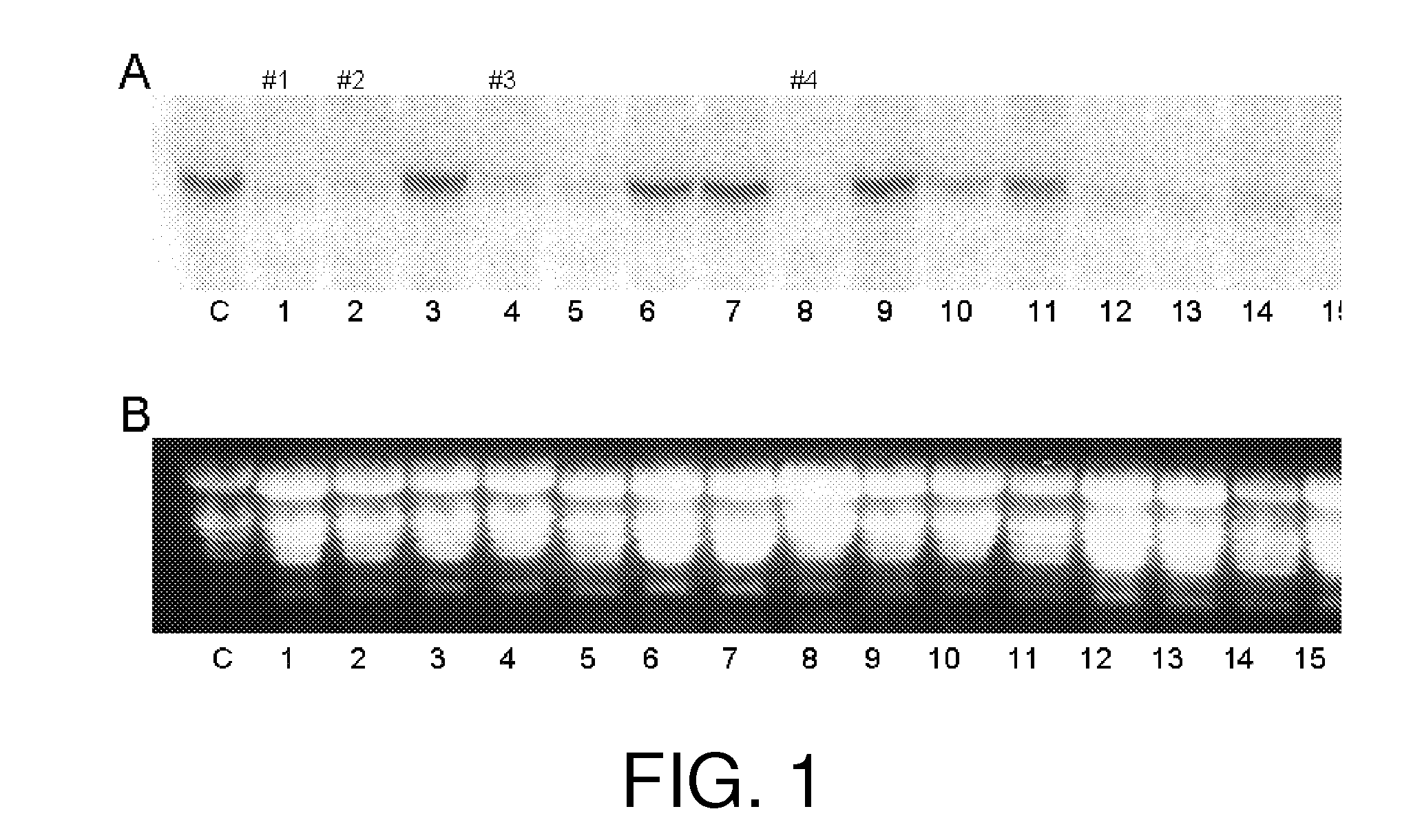Control of cold-induced sweetening and reduction of acrylamide levels in potato or sweet potato
a technology of acrylamide and potato, which is applied in the field of control of cold-induced sweetening and reduction of acrylamide levels in potato or sweet potato, can solve the problems of inability to achieve the effect of improving the processing quality of tubers, unsatisfactory temperature, and inability to accept dark and bitter-tasting chips and fries
- Summary
- Abstract
- Description
- Claims
- Application Information
AI Technical Summary
Benefits of technology
Problems solved by technology
Method used
Image
Examples
example 1
Development of Constructs for Silencing the Potato Vacuolar Acid Invertase Gene
[0127]A search for the potato cDNA of the vacuolar acid soluble invertase gene (VI) on the Institute for Genomic Research (TIGR) (now, DFCI—Solanum tuberosum Gene Index) (Quackenbush et al., 2000) and NCBI's GenBank (Benson et al., 1994) resulted in three VI sequences that share 99% nucleotide identity (TC132799; The Gene Index Databases, Dana Farber Cancer Institute, Boston, Mass. 02115; (Quackenbush et al., 2000) (SEQ ID NO:1), L29099 (SEQ ID NO:2) and AY341425 (SEQ ID NO:3); Table 4). Based on these sequences a 2351 by full-length VI cDNA in potato was obtained (Table 4; SEQ ID NO:4). The cDNA sequence extracted from the databases was confirmed by re-sequencing the cDNA sequences amplified from potato cultivar, Katandin, using the following primer sets:
[0128]Set 1 (amplifies a 810 by region corresponding to 293-1102 by of SEQ ID NO:4)
F1:ttatgcgtgg tccaatgcta20(SEQ ID NO: 5)R1:aacccaattc cacaatccaa20(SE...
example 2
Confirmation of Transgenic Plants
[0134]Transgenic Katandin lines obtained from the three constructs were first screened for the presence of the Kanamycin resistance selection marker. PCR was performed on genomic DNA isolated from the transgenic lines along with non-transformed controls, using the Kanamycin marker-specific primers (primer set 7; SEQ ID NOs:18 and 19):
F7:ccaacgctat gtcctgatag20(SEQ ID NO: 18)R7:tttgtcaaga ccgacctgtc20(SEQ ID NO: 19)
[0135]Presence or absence of a single 531 by of PCR product was confirmed in a transgenic plant. PCR was performed for 40 cycles of heat denaturation at 95° C. for 20 seconds, annealing at 53° C. for 30 seconds and extension at 72° C. for 1 minute after an initial heat denaturation at 95° C. for 1 minute. The PCR reaction mix (25 μl) consisted of 1×PCR buffer, 0.1 mM dNTPs, 0.2 μM primers, 1.5 mM MgCl2, 1 U of Platinum Taq polymerase (Invitrogen) and 1.5 ng of genomic DNA.
example 3
Confirmation of VI Gene Silencing
[0136]All transgenic Katandin plants obtained from three independent transformations were screened for silencing of the VI gene by Northern blot hybridizations. Total RNA was isolated from potato leaves using the QIAQUICK® RNA Isolation kit (Qiagen). Approximately 15 μg of RNA was loaded in each lane and resolved on denaturing 1% agarose gel and then transferred to HYBOND™+nylon membrane (Amersham Biosciences, Piscataway, N.J.). SEQ ID NO:20 of VI cDNA sequence (Table 5) was PCR amplified with primer set 8 (SEQ ID NOs:21 and 22):
F8:acaggggcta gcgtgactgc20(SEQ ID NO: 21)R8:cggcgaaatc acgtgctcta ag22(SEQ ID NO: 22)
[0137]The probe was radioactively labeled with 3000 Ci / mmol [32P] dATP (Amersham) using the STRIP-EZ® DNA kit (Ambion, Austin, Tex.) following manufactuer's instructions. The gel blot membrane was prewashed in 65° C. Church buffer (7% SDS, 0.5M Na2HPO4, 1 mM EDTA, pH 7.2) for a minimum of 1 hour. The radioactive probes were denatured and then...
PUM
| Property | Measurement | Unit |
|---|---|---|
| Fraction | aaaaa | aaaaa |
| Fraction | aaaaa | aaaaa |
| Temperature | aaaaa | aaaaa |
Abstract
Description
Claims
Application Information
 Login to View More
Login to View More - R&D
- Intellectual Property
- Life Sciences
- Materials
- Tech Scout
- Unparalleled Data Quality
- Higher Quality Content
- 60% Fewer Hallucinations
Browse by: Latest US Patents, China's latest patents, Technical Efficacy Thesaurus, Application Domain, Technology Topic, Popular Technical Reports.
© 2025 PatSnap. All rights reserved.Legal|Privacy policy|Modern Slavery Act Transparency Statement|Sitemap|About US| Contact US: help@patsnap.com



